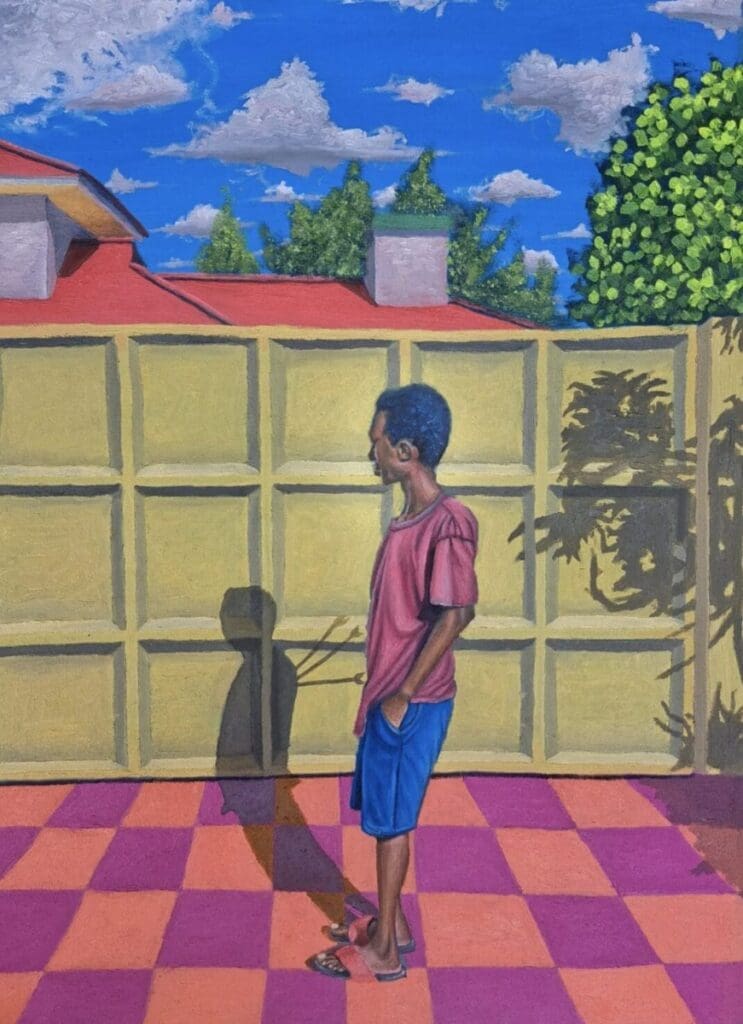Black Arts & Culture Feature:
Gavin Kendo, born in 1997 in Nairobi, Kenya, is a rare figure in contemporary African art: a surrealist. At a time when many young African artists are turning toward documentary realism or Afrofuturist narratives, Kendo stands apart, mining the inner world—his dreams, memories, and psychological terrain—as both subject and medium. His work explores the fluid space between waking life and imagination, using both traditional oil painting and digital tools to construct intricate, introspective visions of African identity.
A Surrealist Voice from Nairobi
Surrealism, while globally recognized, has had only a few African interpreters who have built their practice around its philosophy of exploring the unconscious. Kendo’s contribution to this lineage is both innovative and deeply personal. He draws not only from Western surrealist traditions but also from African cosmologies, oral storytelling, and symbolism to create layered dreamscapes. His art is populated by spectral forms, floating landscapes, and fragmented figures—visual metaphors for memory, displacement, and internal transformation.
In a continent where much artistic attention is focused on socio-political commentary, Kendo dares to look inward. His practice centers on introspection, emotion, and imagination as powerful tools for cultural commentary. He positions the inner life as valid and urgent, reminding us that the psychological is also political.

Blending Mediums: Digital Meets Traditional
Kendo’s distinctive style comes from his seamless movement between oil on canvas and digital media. In his hands, the brushstroke meets the pixel. This hybridity is not merely a formal experiment—it reflects the contemporary African condition, where tradition and technology are not at odds but coexist in everyday life.
Working across mediums allows Kendo to push the boundaries of visual language. In one moment, he may paint a delicate figure using thick impasto techniques; in the next, he may extend the composition digitally, layering the scene with glowing elements or subtly animating textures. This back-and-forth between the tactile and the virtual gives his work an atmospheric quality, blurring time, place, and perception.
His process often begins with oil or acrylic paintings, which are then digitally altered to add depth or new narrative elements. In some works, the digital becomes the foundation, and traditional methods bring it back into the physical world. This loop—between analog and digital, between past and future—creates a new visual syntax for African surrealism.
Portfolio of the Subconscious: Self-Portraits and Inner Landscapes
Kendo’s portfolio is unified by his ongoing exploration of the self. His surrealism is not escapist; rather, it functions as an expanded form of autobiography. Many of his works can be read as self-portraits—sometimes literal, sometimes symbolic. Through fragmented bodies, shadowy doubles, and floating masks, he reflects on the multiple selves we carry: the public, the ancestral, the imagined, and the becoming.
These works are rich with metaphor. A faceless figure in an endless corridor, a floating head tethered to a city skyline, or a lone character walking through a fractured dreamscape—each painting invites the viewer into Kendo’s internal world, while also echoing broader themes of identity formation, alienation, and cultural hybridity.
His use of surrealist aesthetics—elongated limbs, spatial disorientation, dream logic—is not simply stylistic. It’s a deliberate tool to express the complexity of living in a postcolonial, digitized Africa where reality is constantly being reshaped by both historical trauma and digital possibility.


Lost In A Day Dream: A Defining Moment
Kendo’s first solo exhibition, Lost In A Day Dream, held in Nairobi, marked a significant milestone in his career. The show brought together a body of work that spanned both digital and traditional practices. The title itself—Lost In A Day Dream—was a manifesto of sorts, affirming Kendo’s commitment to interiority and the dream world as legitimate creative territory.
The exhibition received strong acclaim for its conceptual ambition and visual cohesiveness. Viewers were particularly struck by the interplay between the digital and the handmade, as well as the psychological intensity of the pieces. Through immersive storytelling and bold visual experimentation, Kendo introduced a new way of seeing and feeling art from Africa—one that prioritizes emotion, abstraction, and layered identity.
A Trailblazer in African Surrealism
Gavin Kendo is not just an artist—he is a provocateur, challenging how African art is defined, made, and consumed. His work expands the scope of what it means to be a contemporary African creative, moving beyond documentary forms into the territories of myth, dream, and subjective experience.
In blending traditional techniques with cutting-edge digital methods, Kendo represents a new generation of African artists who are unafraid to cross disciplines, genres, and technologies. His influence is growing—not only among audiences, but among peers who are also beginning to explore hybrid forms of making.
As African surrealism continues to gain visibility on the global stage, Gavin Kendo’s work offers a powerful reminder: the most radical act may be to paint what cannot be seen—to give form to the invisible, the subconscious, and the in-between.
Read more from the original source


